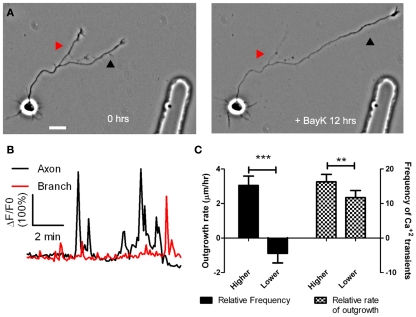Figure 3.
BayK induced calcium transients, which persist throughout long term treatments, are correlated in their frequencies with process outgrowth. (A) Phase images of a cortical neuron treated with BayK in the bath for 12 h. At the end of the imaging session the process at right (black arrowhead) had extended, whereas the process at left (red arrowhead) retracted. (B) After phase imaging, cortical neurons were loaded with Fluo-4 and calcium activity was measured. The extending process in (A) (black) showed high levels of calcium activity compared with the retracting process (red). (C) Quantifications from 16 experiments imaging calcium activity after long term BayK treatments revealed correlations between BayK induced differential calcium activity and process outgrowth. At left comparisons between processes from the same axon showed that those with higher frequency calcium transients had higher rates of outgrowth, whereas those with lower frequencies retracted (n = 22 comparisons; ***p < 0.001, paired t test). At right processes that extended faster had higher frequencies of calcium transients (n = 26 comparisons; **p < 0.01, paired t test). Scale bar, 20 μm. (Reprinted from Hutchins and Kalil, 2008; with permission from the Society for Neuroscience).

